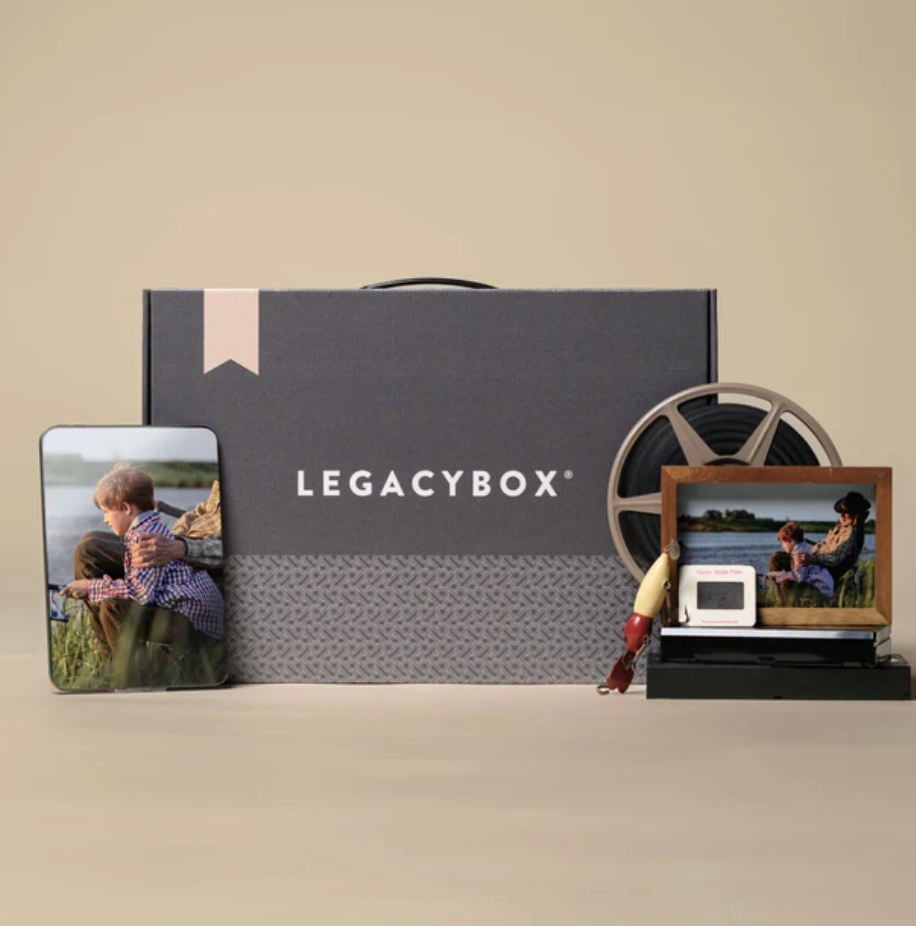I’ve been spending some time this year bringing some old memories into the present, not only so that my family and I can enjoy them now, but also so that they are preserved for the future. Earlier this year, I discussed using the Kodak Slide N Scan Digital Film Scanner (Amazon link) to scan 35mm slides and negatives. It was great fun to see the old pictures that were in slide carousels and at risk of never being seen again. But of course, there are other forms of old media. I recently came across a treasure trove of 8mm film reels at my parents’ house that were recorded between the 1950s and the 1980s. I wanted to digitize them so that I can watch them on a TV and share the videos with family members.
You can purchase equipment to digitize 8mm film yourself, such as a $419.99 product called KODAK REELS. However, for the reasons I explain below, I decided instead to pay the experts at Legacybox to do it for me. I was very happy with the results.
Why digitize
This part may be obvious, but there are significant reasons to digitize old 8mm films. Even if you still have access to an old projector—there was one in a closet in my parents’ house—is it actually going to work? Moreover, it is cumbersome (albeit nostalgic) to set up a projector and a screen (or a white wall or a white sheet on a wall, all things that I remember doing when I was very young) and have everyone gather around. It is much better to have the film in a digital video format so that it can be watched on a big and bright TV screen or on an iPhone or iPad. Plus, once the film is in a digital format, it is easy to share the video with others.

Also, once the film is in a digital format, you can do more with it. You can combine multiple related film reels into a single video. You can also split a single film roll into different events. For example, I sometimes found both Thanksgiving and Christmas on the same roll. Critically, for some old films, you can use software to restore some of the lost color in the video so that it can look closer to how it originally looked. You can also stabilize parts of the video to correct for the inherent limitations of old camera hardware that was made when people knew nothing about using software to stabilize video—and, for that matter, knew nothing about what “software” is. You can also enhance the video by adding titles, transitions, etc.
Additionally, digitizing film is a way to preserve the video for yourself and future generations. How long does an 8mm film last? According to the U.S. National Archives and Records Administration, they can survive “for decades as long as they are kept in a stable environment that is not too hot, too dry, or too wet.” I’ve seen many people say to expect about 70 years. But for films taken in the 1950s, we are already at that life span, and films from subsequent decades do not have much longer.
Speaking of the years that these films were taken, I expected to find films from the 1970s, when I was a child. I was surprised to find in that closet many videos from the 1950s and 1960s, videos taken by my parents and grandparents that I didn’t know existed. And I was equally surprised to find films from as recently as late 1985; I would have guessed that the move from Super 8 film to VHS-C (with sound) had occurred for my family even earlier in the 1980s.
How Legacybox works
To use Legacybox, you pay in advance for a box (I discuss the cost below), and you put your films in the box. The box sizes are Starter (two items), Family (10 items), Closet (20 items), or Trunk (40 items). Legacybox ships the box to you. You add your items, send the box back, then they scan the items and send the videos to you in the format that you select—such as online, where you can download them. Finally, your original films are returned to you. Here are more details on how everything works.
I used Legacybox for film reels recorded using a home video camera. And I even found one such camera with the reels.

Film reels come in different sizes. Eastman Kodak started selling consumer 8mm spools in the 1930s, and released the higher quality (and easier to use) Super 8 format in 1965. Each roll had 50 feet of film, and a single spool of film is three inches wide. At the standard speed of 18 frames per second for Super 8, a single roll could record around three minutes.
After the film was developed, it was common to splice multiple three-inch reels into a single reel that was five or seven inches (or larger). I remember that when I was a teenager, my mother gave me and my brother a summer project of splicing together multiple film reels from the same event to make single reels. We also sometimes combined multiple events over time, such as a single reel with multiple years of Christmas films.
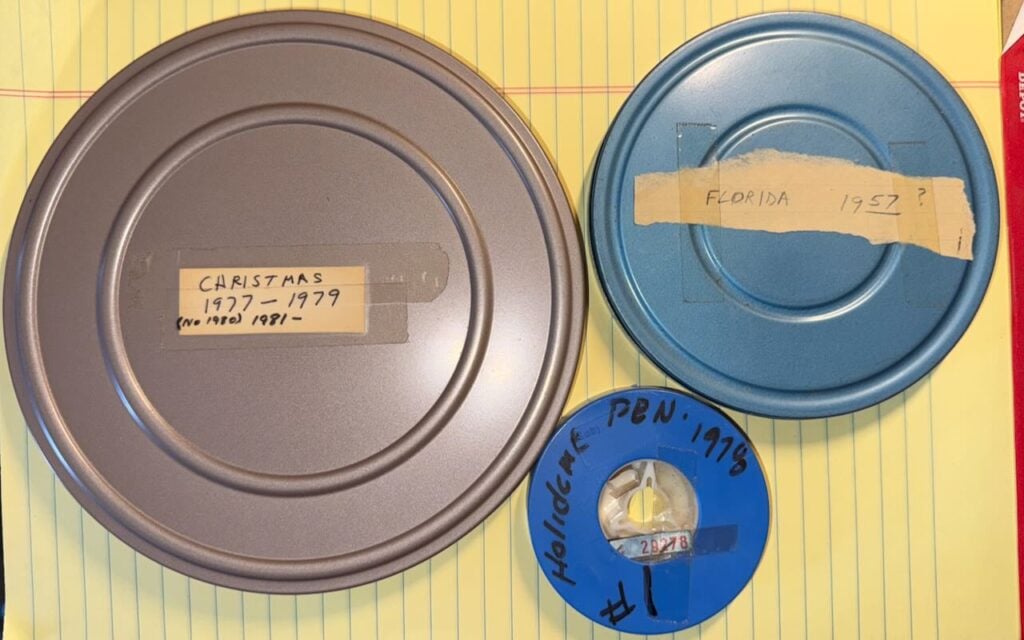
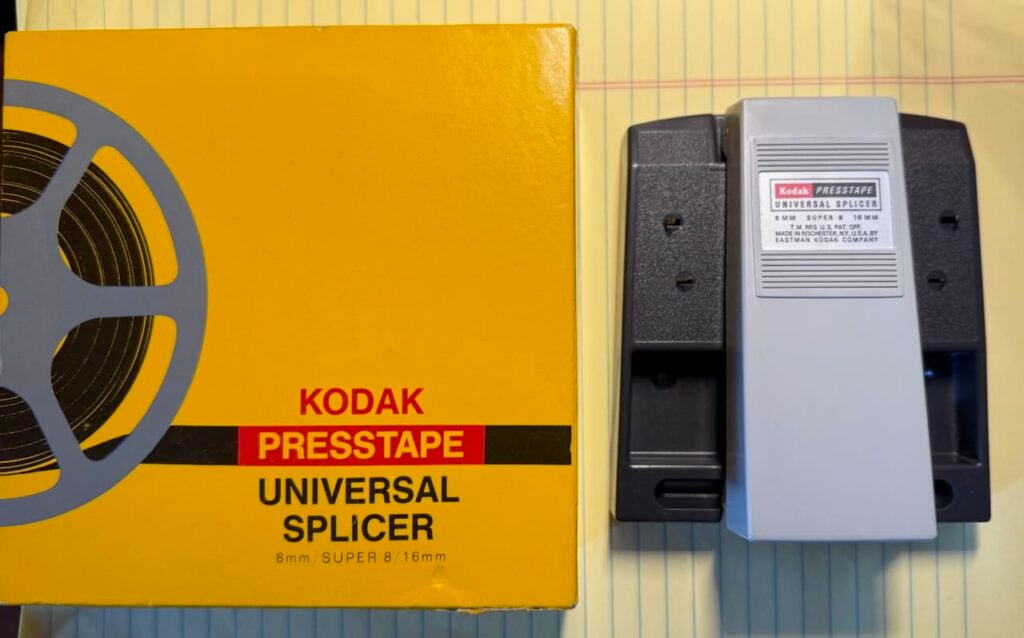
Each reel, no matter the size, counts as a single item for a Legacybox order. Thus, my work in the early 1980s combining eight three-inch reels into a single seven-inch reel meant that I only needed to pay Legacybox for one item instead of eight items. (Thanks, younger me!)
Legacybox also digitizes other media types, such as VHS video, photo slides, and negatives. A set of 25 photos counts as a single item. But I only used the service for 8mm and Super 8 film.
After you select a box size and pay for it, Legacybox sends you the box along with an instruction booklet and stickers. I purchased a Trunk, so I had 40 stickers. Each sticker had my order number followed by a number, 1 through 40. I placed the stickers directly on each film reel (not the film canister or box).
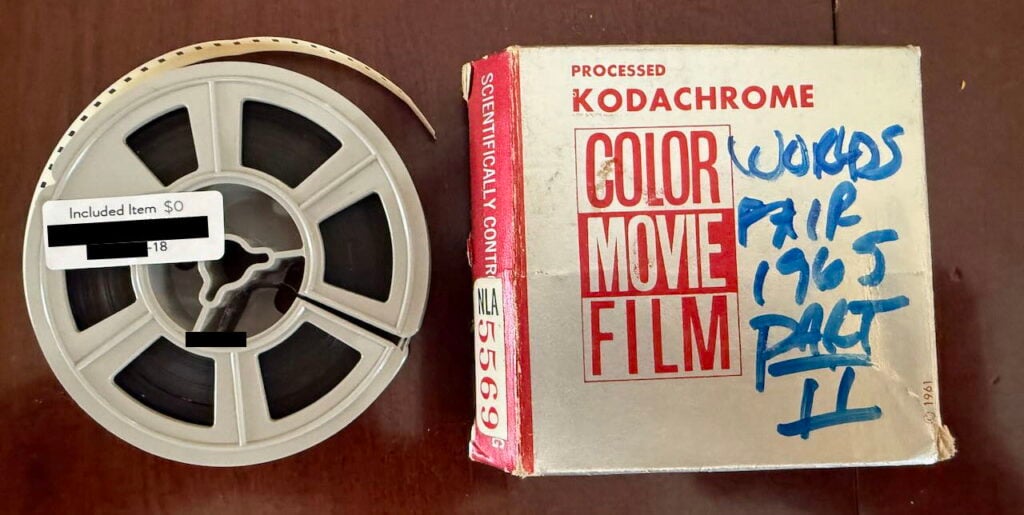
Pack up all of your items and put them in the items box, add some bubble wrap or something similar to keep everything nice and safe, place that box into the shipping box, and then apply the pre-paid shipping label and send the box to Legacybox (located in Chattanooga, Tennessee) via UPS.
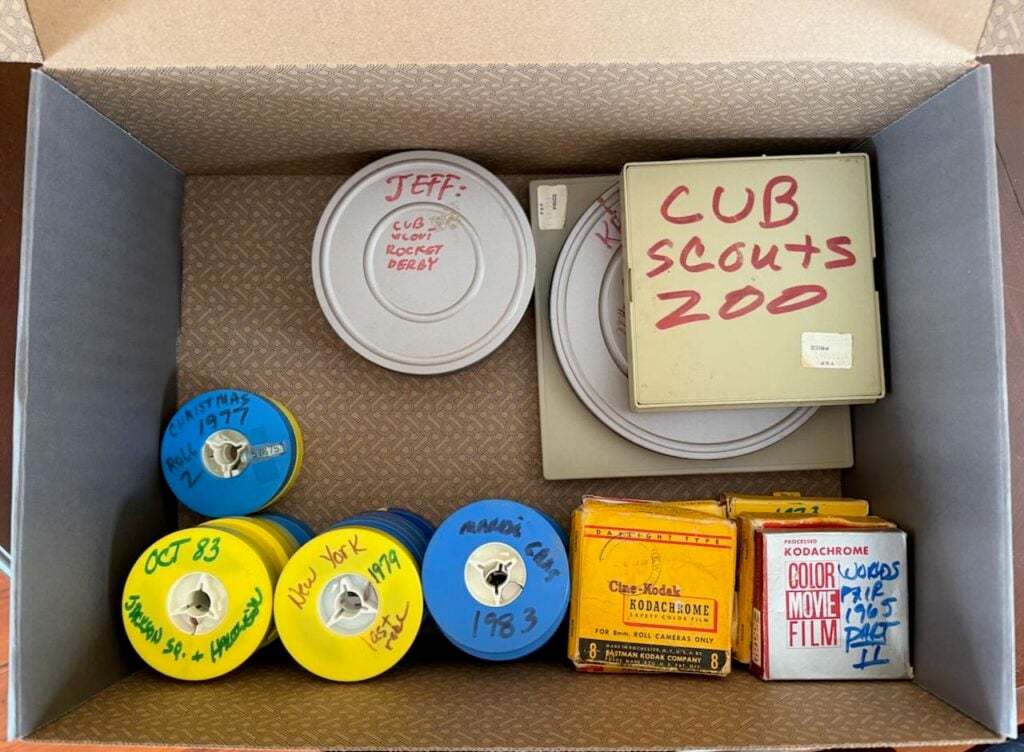
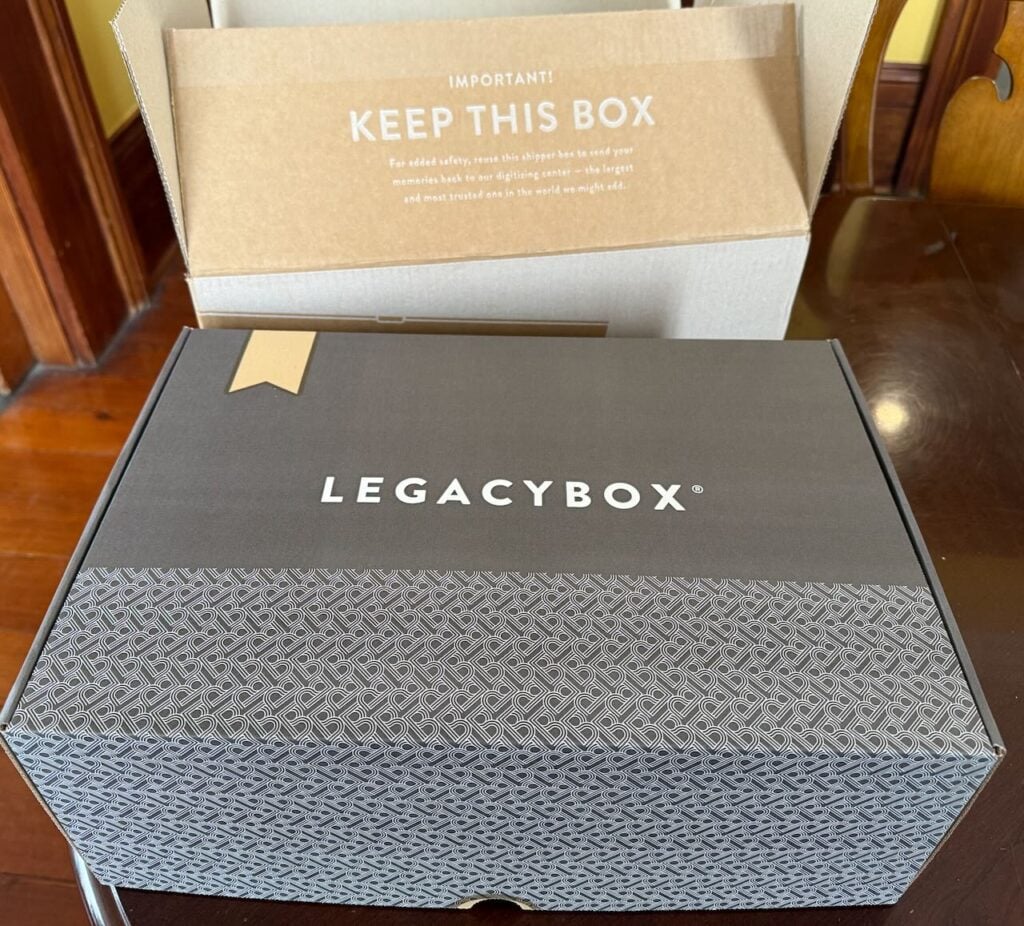
Digitizing your film
When Legacybox receives your films, they scan every frame, compile the footage for each reel, and correct the frame rate so that the film speed looks natural. Unlike old projectors that use hot bulbs and can potentially melt film, Legacybox uses LED lights that run cool. Legacybox also takes some steps to remove flicker, although occasionally, I still saw a little of that in the final product (but nothing obnoxious). Legacybox does not correct the colors, does not stabilize shaky video, and does not perform any other edits. Those are steps that you need to do on your own, if you want them.
Legacybox does a great job of sending you emails to keep you updated on the process. They tell you when they sent you an empty box and when they received your box full of items. They tell you when they have catalogued your order and how many items they found (such as five 7-inch reels, four 5-inch reels, etc.). They tell you when they begin working on your films. And they tell you when the films are posted to the Legacybox cloud service so that you can start to view and download them.
Legancybox told that it can take up to 4-6 weeks to digitize the videos. However, over the past few months, I have ordered two Trunk boxes at different times, and both times, it took only about two weeks to digitize my videos. I did not pay extra for expedited service, nor did I reveal that I would be writing this review.
You can pay extra for Legacybox to create a DVD with your videos, but I don’t see why that is necessary for most people. When you get a link to the website with your videos, simply download the videos to your computer. After 30 days, it costs $4.99/month to keep your videos on that Cloud service, and I don’t see any reason to do so once you have downloaded your videos. Make sure you remember to cancel that Cloud subscription once your videos are safely downloaded to your device.
For my seven-inch reels, the video running time was up to around 30 minutes. The file sizes varied; a 30-minute video could be as much as 1.3GB, but other videos of similar length had smaller files. Videos from the standard three-inch reels varied from around 30MB to almost 100MB.
Note that there are apparently some 8mm film cameras that record sound. All of the 8mm films that my family took were silent films, and Legacybox says that they cannot digitize the sound portion of an 8mm video if there is sound. If you are lucky enough to have 8mm film with sound, you should find another service that handles that.
Legacybox says that your items are kept secure. The website says: “Your orders are processed in our secure, climate controlled, 38,000 square foot processing facility, located right here in the USA. We utilize the latest in barcoding and tracking technology (we even have developers on staff), so we know exactly where your order is at every moment.”
Working with the videos
Of course, you can watch the videos from Legacybox right away. I was having lunch in my office when I learned that my first set of videos was available. I downloaded them to my iPad and started watching some of the videos right away, and they brought tons of smiles to my face. The ones taken before I was born or when I was young were fascinating to watch. The ones taken when I was a little older brought back so many memories. I saw old friends that I haven’t seen in decades, family members who have long since passed away, Christmas morning videos that showed me when I first received items that I subsequently used for many years, and more. Seeing the bedroom that my brother and I shared before we moved to a new house when I was ten years old brought back a wave of memories for every single item on the dresser, bookshelf, and wall.
You could just watch the videos downloaded from Legacybox, but I took the time to improve each video using Final Cut Pro. (You could also use iMovie.) I often found multiple events that were on a single reel, so I broke those up into different videos. Or sometimes, a single event would run across two to three three-inch reels, so I would merge those into a single video.
For some videos, the color was surprisingly good. For others, one or more of the colors had faded over time, so I adjusted the color levels and saturation using Final Cut Pro—the same things that I often do with a scan of an old photograph using the Photos app, Photoshop, and/or Pixelmator Photo. Video taken with a handheld camera that lacked any of the image stabilization that we have on a modern iPhone can be very shaky, so in some cases, I used the Final Cut Pro feature to stabilize the video. But most of the time, I left the shaky video as it was because that is sort of what you expect to see with old videos. I also added titles and dates to the videos—sometimes taking that information from the film reel canister, and other times doing some sleuthing to figure out the date. Some of my videos did not match the film canister, so the contents of the video were a surprise. I ultimately ended up with 72 different videos from the first 40 reels that I sent to Legacybox.
I have an account on SmugMug where I share photos and videos with friends and family members to whom I have given the password, so that is how I have been sharing my final videos from these old film reels. But you could, of course, upload your videos to a service like YouTube and share the videos with others that way.
How does it look?
For most of the videos, I thought that the quality was really good, especially considering that I know my family was using pretty basic consumer equipment to record home movies way back when. For a few others, the quality was just so-so. When I recently showed some of these videos to friends and family members, multiple people remarked that they were surprised that the quality was as good as it was, so I’m not the only one who had that reaction. Most importantly, though, the biggest impact came from seeing the content of the video—the people and places from long ago—so the quality of the transfer was an important but secondary consideration.
One thing to note is that there seems to be some slight cropping on the left and top sides of each video.
I uploaded a video to YouTube with some examples from the 1950s to 1970s, if you want to get a sense of what the quality can look like when you have Legacybox digitize 8mm film reels. I added subtitles so that you can tell when you are looking at the video I downloaded from Legacybox versus when you are looking at video that I improved using Final Cut Pro, such as adjusting the colors or stabilizing shaky video. If you need some help restoring an 8mm film clip using Final Cut Pro, this YouTube video from Kat Tingum has some good tips.
Customer service
I’ve already mentioned that I like how Legacybox communicates with you during every step of the process. I also had a very good experience when I encountered a problem.
One of the reels that I sent to Legacybox was a seven-inch reel. Based on the other reels of similar size that I sent to Legacybox, I expected the video to be between 20 and 30 minutes. But instead, the video that Legacybox sent me for that reel was only about eight minutes long. That just didn’t seem right to me. So I reached out to Legacybox to ask if perhaps they had not digitized it the whole way through. They immediately responded to my inquiry and said that they would address this right away. They gave me a pre-paid shipping label so that I could send that single reel back to Legacybox. And they gave it priority treatment so that as soon as they received it, it was digitized immediately. Sure enough, the second time around, the final video from that reel was 24 minutes long.
Of course, it would have been better if the entire reel had been correctly processed the first time. But the company was so responsive and fast when I alerted them to the potential problem that it left me very satisfied.
The cost
There are a number of services that advertise the ability to digitize old videos, but when I did my research, Legacybox seemed to be the one that most people preferred. Note that there are two other companies that may seem like competitors to Legacybox, but they are actually the same company, and they use the same facility in Chattanooga, Tennessee. Legacybox, Kodak Digitizing, and Southtree are all part of AMB Media, LLC.
What does it cost? There is not a simple answer. The website tells you that there is a “normal” cost, but the website always seems to have a substantial discount of 50% or more. For example, as I am typing this, the website advertises a 55% discount, and the discounted cost is: Starter (2 items) $31.60; Family (10 items) $144.00; Closet (20 items) $288.00; Trunk (40 items) $562.50. Not that long ago, the website was advertising a 50% discount.
I also discovered that if you go to a different page of the Legacybox website, there is a 65% discount, which brings the four prices down to $28.99 / $124.99 / $239.99 / $439.99. That page says that the 65% discount ends in a week, but it said the same thing when I used that same 65% price about a month ago. The way that this particular 65% discount works is that you purchase a coupon code, then you go back and place an order using the 50% discount (or whatever), but then instead of providing a credit card, you provide that code, and that covers the price of the entire order.
I’m not a fan of the practice of constantly claiming that there is a limited sale, urging you to act now when there really is no urgent need to act now. And I don’t like it that different parts of the website advertise different prices. From what I can tell, 65% seems to be the largest discount that has been offered for a while, so I urge you to look for a discount at or near 65% when you use the service.
As I noted above, instead of using Legacybox or one of its competitors, you could purchase something like the $419.99 Kodak REELS and scan the videos yourself. I thought about going this route, but ultimately decided to let a professional do it. First, these devices get pretty bad reviews online, with lots of people saying that they are finicky to use and break easily, especially if you use them to digitize a large number of reels. Second, it takes a lot of time to use them, about 30 minutes for a three-inch reel and many hours for larger reels. I prefer letting Legacybox do all of this work digitizing videos, which lets me spend my time just editing the videos. Third, I have seen mixed reviews about the quality of the scan from a device like the Kodak REELS as compared to Legacybox. To be fair, you can find people online who complain about the quality of Legacybox too, even though I was very satisfied.
Conclusion
Being able to watch family home videos from long ago that otherwise would have been lost to time has been fantastic. Sometimes, it was a video from an event for which I only remember seeing a few photographs in the past. With the video, it was like those old photos came alive. Sometimes, it was a video from an event that I remember, at least a little bit, but the video brought it back to life again. There are even some events from when I was little for which I thought I had a memory of the event, but now that I’ve seen the film, I think that I may just be remembering watching the film years later when I was older. And of course, seeing videos of loved ones who passed away long ago has been really nice.
I have also enjoyed editing what Legacybox sent me to create individual videos for each event—although, of course, you could skip that step if you are not comfortable working with software like Final Cut Pro, iMovie, Adobe Premiere, Camtasia, DaVinci Resolve, or the others.
My only regret is not using Legacybox years ago. I would have loved to have watched many of these videos when my mother and grandparents were still alive, so that they could have answered many of my questions about what I was seeing and shared stories about the events from long ago. Nevertheless, the next best thing is to do it now. Indeed, if I had waited much longer, perhaps some of the films might have deteriorated.
My only complaint about Legacybox is the way that they handle pricing, but if you are a smart shopper and look for the 65% discount, you can get around that.
Overall, I was happy with Legacybox, and I recommend the service. Indeed, a few weeks after I ordered the first Trunk with 40 film reels, I ordered a second Trunk and sent in 40 more reels. They were digitized just a few days ago, and I have just started to edit them. I see that I still have around 40 film reels left in the box that I found in my parents’ house, so I guess I will order one more Trunk from Legacybox when I’m done with this second set.

